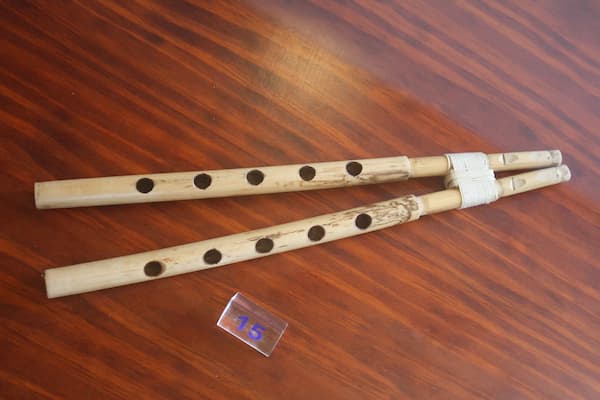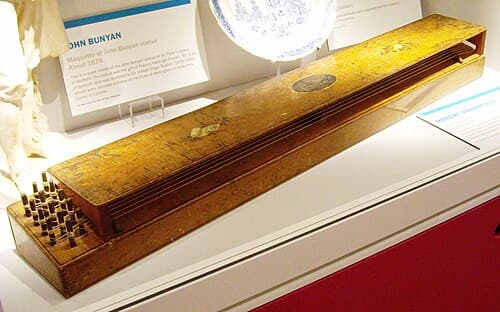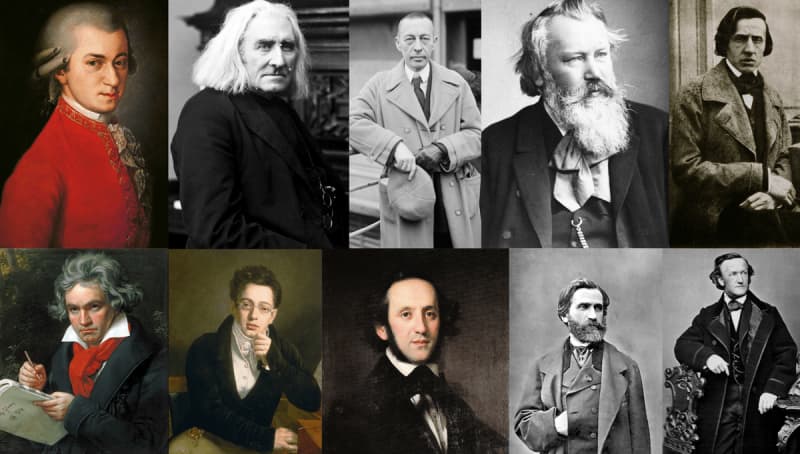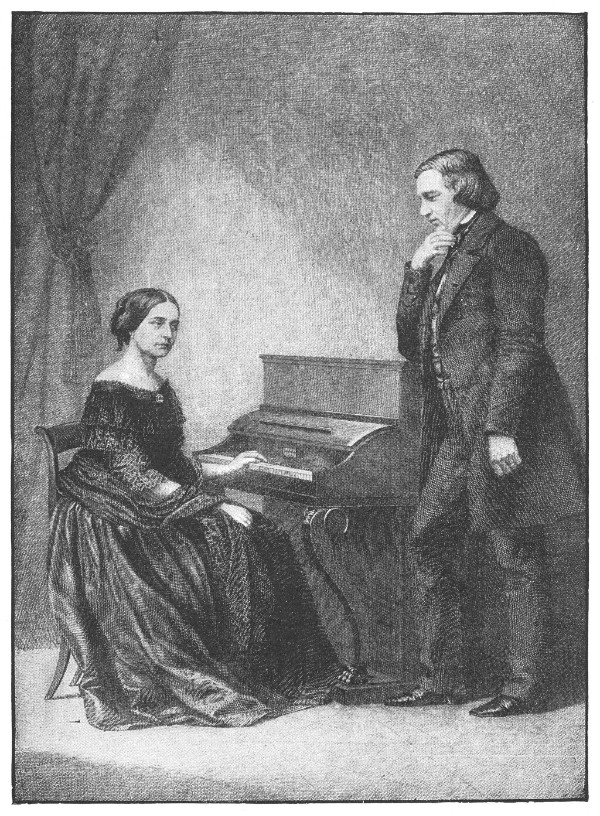Human beings are endlessly creative: for at least 60,000 years, we’ve been finding weird and wonderful ways to make sound. Learn about some of these lesser-known sonic devices, delving into realms of history, culture, and myth.
The Aulos

The Aulos © worldhistory.org
The aulos can be traced back to 2,450 B.C., but most of our surviving records of its use are from Ancient Greece and Rome. A double-reeded woodwind instrument, the reeds enable a penetrating sound quality that made the aulos perfect for the battlefield, where it could be heard even over the clamour of fighting. The strains of the aulos would also have been used at recitals of elegiac poetry, wrestling matches, dramas, and sacrifices.
Those who played the instruments were called auletes. These individuals required real skill to play the instrument, often needing to wear a kind of “strap” called a Phorbeia to allow them to circular breathe while keeping their lips, the reeds, and the instrument all in place.
In ancient Greek myth, a satyr, Marsyas, was said to have taken up the aulos after goddess Athena cast it aside, irritated that it caused her to puff out her cheeks and destroy her beauty. Marsyas then challenged god Apollo to a musical contest, where he was defeated by the god and his lyre, prompting a long-term symbolic and mythic contrast between the lyre and the aulos in public imagination and signification. Auletes were typically professionals or slaves, while those of leisure and higher classes often played the lyre simply for pleasure.
The history and sounds of the aulos have been revived by a number of musicians and research organisations in Europe, including the Aulos Collective and Callum Armstrong, the Lost Sounds Orchestra, and the Ancient Instruments Sound/Timbre Reconstruction Application (ASTRA) project.
Improvisation in the Greek Enharmonic Modes on the Poseidonia Aulos
The Theorbo

The theorbo © musicbrainz.org
A veritable beast of an instrument, with a range to rival the cello, the theorbo, or chitarrone, is a member of the lute family. Resembling a cross between an enormous tadpole and a construction crane, the theorbo typically has 14 “courses” (string pegs) and is characterised by a special “re-entrant” tuning, with its two upper and longest strings tuned an octave lower than the rest of the string sequence.
An important continuo or accompanying instrument in the French courts of the 17th century, the theorbo was developed in Italy and was of most cultural and musical importance there. In his Le nuove musiche, Caccini opines that the theorbo is an ideal accompaniment to the human voice in its ability to support vocalisations without covering them. This capacity of the instrument gave rise to an Italian tradition of monodic songs set to theorbo accompaniment. Lynda Sayce, theorbist, notes that “many Italian operas of the mid-17th century are essentially continuo operas, and were performed with two keyboard instruments, two theorbos, and a pair of violins to supply instrumental ritornelli.”
Have you seen but a bright lily grow (Feat. Nick Phan)
Aeolian Harp

Aeolian harp made by Robert Bloomfield © Wikipedia
You’ve probably heard of wind chimes, and may even have owned some yourself. But what if the wind could play an even larger and more complex instrument – say, a harp…?
The Aeolian harp gets its name from Aeolus, the ancient Greek god of the wind. A wooden box with a sounding board and strings stretched across two bridges, the resultant sounds depend on the type and tuning of strings, the materials of construction, and of course, the wind. Whether placed near the gentle breeze of an open window or on a blustering seaside cliff, the Aeolian harp always produces gradual crescendi and descrescendi of harmonic overtones – an ethereal, gentle, and glassy sound. Scientists didn’t understand physics behind the harp’s sound production until 1915, when Lord Rayleigh identified that the sound is produced by the von Kármán vortex street effect, whereby motion of the wind across the string causes periodic alternating vortices in a downward stream.
Although an ancient instrument found in regions as disparate as China, Ethiopia, Greece, India, Indonesia, and Melanesia, our first written record of the aeolian harp is by Athanasius Kircher in Musurgia Universalis (1650). However, the idea of the wind playing stringed instruments can be traced back much further, to the lyre. Epic poet Homer wrote a story wherein god Hermes invented the lyre from sinews stretched over a tortoise shell, played by the wind; in the Bible, King David’s lyre is played by a wind sent from God.
The Aeolian harp became a popular household instrument in Europe in the Romantic era, which is likely how Frédéric Chopin came to give his Etude Op. 25, No 1 in A-flat major the alternate name, “Aeolian Harp.” An Aeolian harp stop made to imitate the sound can also be found on many organs.
Today, the largest Aeolian harp stands 28 metres tall: the Lucia and Artides Demetrios Wind Harp, in South San Francisco. Sitting near the Bay and visible from most of the city, the massive monumental harp receives a near-constant sea breeze. Roger Winfield wittily summarises the slightly eerie otherness and unpredictability that come from making music with the wind with the subtitle of his 1991 album Windsongs. The album was made with an “orchestra” of eight Aeolian harps, and Winfield notes in an ironic fashion that the album was “performed by the winds of the North, South, East and West under the musical direction of Roger Winfield.”
Wind Harp – Aeolian Harp on the Irish coast
The Khaen

The Khaen © iainarmstrong.net
In a touching example of the potential of viral internet audio to be a force for good, various remixes of Hal Walker’s original composition Low Key Gliding have introduced the national instrument of Laos, the khaen, to a new global audience. The instrument’s resonant, droning quality, and the capacity for “glitchy” sounds produced by flutter-tonguing – with a remarkably electronic-sounding result – have awakened newfound interest in the instrument.
Consisting of a free reed made of brass or silver, a hollowed-out hardwood reservoir, and bamboo pipes, the khaen is a mouth organ played in a somewhat “caressing” posture, the player holding the instrument with both hands, with much of the instrument close to or covering the face.
Tuned in pentatonic modes called lai, the oldest of which is the Lai po sai, the khaen is most often played solo, as a vocal accompaniment, in duos with the phin lute, and in Cambodian dance dramas, lakhon ken. The khaen is an important instrument for different cultural groups across Laos, Cambodia, and Vietnam, and in 2017 was included in the UNESCO Representative List of the Intangible Cultural Heritage of Humanity. From its role in promoting group singing and dance at village festivals, to the promotion of natural agriculture practices in producing bamboo for its pipes, to the way khaen is taught through familial generations, the khaen plays an integral role in Lao culture.
For more of the best in classical music, sign up for our E-Newsletter



